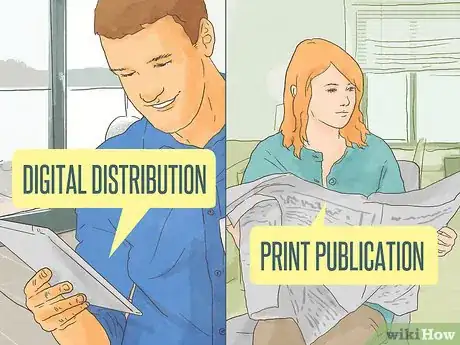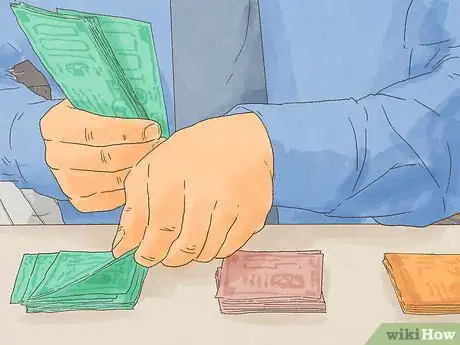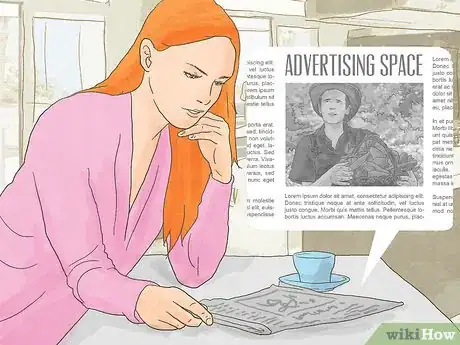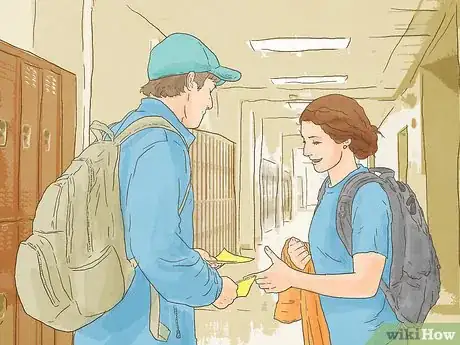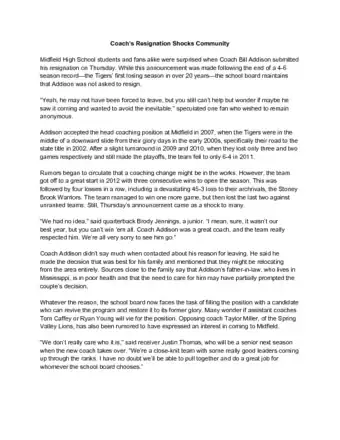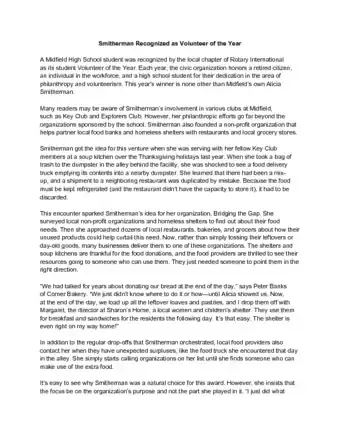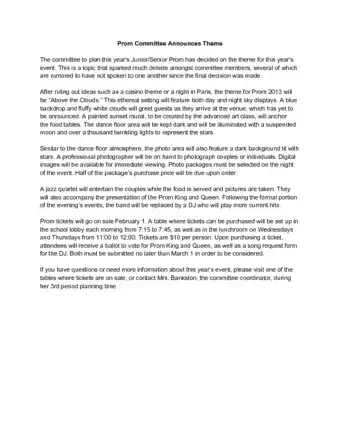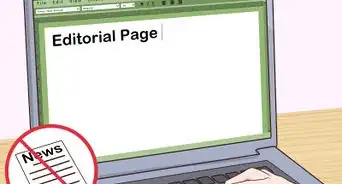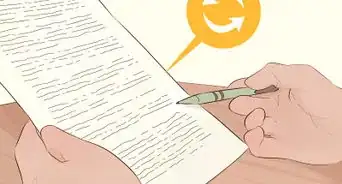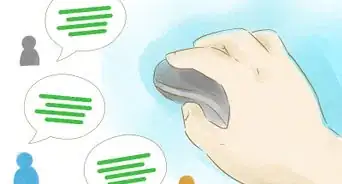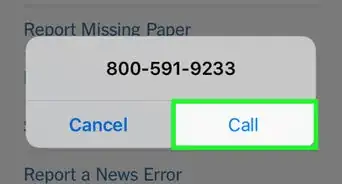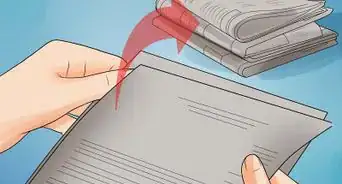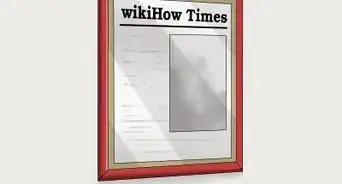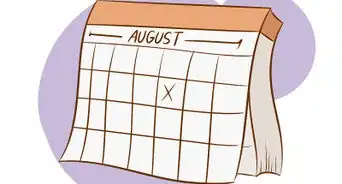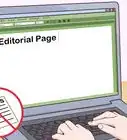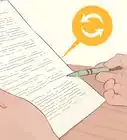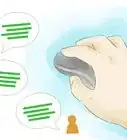This article was co-authored by Alicia Oglesby. Alicia Oglesby is a Professional School Counselor and the Director of School and College Counseling at Bishop McNamara High School outside of Washington DC. With over ten years of experience in counseling, Alicia specializes in academic advising, social-emotional skills, and career counseling. Alicia holds a BS in Psychology from Howard University and a Master’s in Clinical Counseling and Applied Psychology from Chestnut Hill College. She also studied Race and Mental Health at Virginia Tech. Alicia holds Professional School Counseling Certifications in both Washington DC and Pennsylvania. She has created a college counseling program in its entirety and developed five programs focused on application workshops, parent information workshops, essay writing collaborative, peer-reviewed application activities, and financial aid literacy events.
This article has been viewed 45,914 times.
Does your school have a newspaper? If not, you could be responsible for creating one. Forming a new club will look great on your resume. You will also gain invaluable experience writing and editing, and may make new friends. To start a newspaper, form a game plan. Recruit a staff and figure out your newspaper's goals and missions. From there, work on getting funding for your paper. Assign articles so you can write, design, and print your first paper.
Steps
Creating a Solid Foundation
-
1Recruit a staff. It would be difficult to run a newspaper on your own. The first step should be recruiting dedicated, likeminded students to work as your staff.
- Think about the various rolls you need to fill. In addition to writers, you need people to take pictures, design the layout, and help with advertising your paper.
- Look for people who enjoy writing. Ask in an AP English class, for example. You should also look for people with technical skills. If there's a computer club in your school, see if anyone would be interested in working on the paper.
-
2Decide how you'll print your paper. There are many different outlets for publishing a student paper. You should decide how you want to publish. This will help you figure out what resources you need, as well how much money you will need.
- You can publish a paper online. As more and more people are turning to the Internet for their reading, this may be a good option. You can use a site like WordPress to start a blog.
- If you're attached to the idea of a print publication, think about how you'll go about this. How many pages will your paper be? What size paper will you use? Do you have the resources to print multiple copies of a paper?
- Figure out where you can find a printer equipped to print out a paper. You can ask a local newspaper if you can use their printer. You can also stop by a local print shop, such as a FedEx, and see how much they charge.
Advertisement -
3Think about your content. Your paper should have some kind of mission statement and goals. What sort of content will you produce? What kind of newspaper do you want to create?[1]
- It's important to know what's important to other students in the school—this can give you some material to use for your newspaper.
- Think about what genres of writing you will include. What kind of news stories would you want to tackle for your feature articles? Do you want to stick to unbiased reporting, or include some editorials as well? Should you just include the basic news or look for interesting or controversial stories?
- Think about lighter subjects you wish to include. Will you have someone to cover sports? Entertainment? School events? Will these be on the front page of your paper, or kept in a separate section?
- Write up a mission statement. It can begin with something like, "The goal of our paper is to provide students a unique voice and report on issues relevant to our school."
-
4Find a meeting space. Once you know the kind of resources you need, you'll have an idea of the kind of meeting space you want. Talk to your school's principal about booking a classroom to meet for the newspaper.
- Make sure you get a room with the right resources. If you're doing a digital paper, for example, you probably want a room with computers.
- You should also think about space. How many people are on staff? Make sure you have a room that accommodates everyone.
- A whiteboard or chalkboard may be necessary to jot down notes as the meeting progresses. If you plan on giving a presentation overviewing the plans for the paper, you may want a room with a projector.
Gaining the Funds
-
1Create a budget. You should have a sense of how much money you need. Make a list of everything that will cost money. Decide about how much money you will need for each aspect of the paper.
- If you're printing your paper, figure out how much printing will cost. Are you printing at your school or at a print shop? Do you have to pay for paper? How much paper will you use? Figure out the total number of pages you're printing and how much it will cost.
- You will also need other supplies. You may need pens and pencils for editing. You may need to pay for some graphic design software for the technical side. Figure out the costs of these expenses as well.
-
2Think about selling ads. Contact local businesses. They may be willing to give you money for your paper if you're willing to give them ad space.
- Go to businesses trying to attract a teenage audience. The grocery store where your mom shops may not benefit from advertising in a student newspaper. However, the coffee shop that high school students frequent may be interested in ad space.
- Approach managers politely. Explain to them you're starting a newspaper and need funds for printing and other costs. Give them specific details about ads. How big will the ad space be? Where in the paper will the ads appear?
-
3Talk to your school board or student council. They may be able to provide you with funding. School boards often have a certain amount of money they can pass out to student clubs.
- How you request money will vary by school. Ask someone on student council or the school board about the formal requirements for requesting money. In some cases, you may have to register your club with the school before requesting funds.
- You will probably have to explain your plan for the paper. You also may have to explain how it benefits the school. A newspaper can be a great way to teach students about reading, writing, and journalism. It can also help the student body stay informed about current events. These are things worth mentioning when requesting funds.
-
4Do some fundraising. You can raise money on your own. There are many fundraising outlets you can engage in to gain money for your paper.[2]
- Try planning an event like a bake sale, car wash, or talent show. You can sell tickets or goods and services for money.
- Ask a local business if they'll work with you on fundraising. You could, for example, bag groceries at a local supermarket for a day for tips.
- Try an online fundraiser. Sites like GoFundMe can be used to ask for money for a variety of projects.
Writing Your First Paper
-
1Assign articles. Once you've gained funds, begin work on your paper. The first step is assigning articles. Make sure each writer has an article that matches his or her skills.[3]
- Pick articles that match each writer's skills. A student that tends to be the class clown my be best suited to write a comedic article. A politically inclined student could write an op-ed about current events.
- Make sure you're covering everything you want to cover. You cannot give everyone their first choice article. Some news stories may not be interesting, but remind your staff there are no small parts. Everyone makes a valuable contribution to the paper, and there's always the next issue to get a better article.
-
2Figure out the layout. You want to know what your paper will look like. Schedule a meeting with the students working on graphic design. Talk over what you want the layout to look like like.[4]
- Think about where you want to place stories. Which stories will be on the front page? Will you have separate sections for things like sports, politics, arts, and entertainment?
- Are you going to print in color? Are photographs included? How will these be integrated into the articles?
-
3Create content besides writing. A newspaper would be a little boring if it only had written content. Think about other things you could include in your first issue.[5]
- You should include photos. A photographer can add a visual element to articles.
- Do you have anyone who likes to draw? Including some cartoons can help.
- Think about including things like puzzles. A crossword puzzle or word scramble can be a fun addition to your paper.
-
4Edit your paper. It's always good to give your paper a quick proofread and edit before sending it out. Assign teams to edit everyone's content carefully. You can give writers advice for revisions, and also proofread for general clarity.
- It's not unusual for people to miss their own errors when reading their work. Therefore, it may make sense to have students swap articles with one another.[6]
-
5Market your paper. In the days before your release, make sure students know your paper is coming out. You want to make sure the paper is widely read.[7]
- You can hand out flyers at the beginning your classes. You can also put posters up around the school.
- If you're doing an online paper, see if you can send your school a mass email the day your paper comes out.
Sample Articles
Expert Q&A
-
QuestionHow do I start a school magazine?
 Alicia OglesbyAlicia Oglesby is a Professional School Counselor and the Director of School and College Counseling at Bishop McNamara High School outside of Washington DC. With over ten years of experience in counseling, Alicia specializes in academic advising, social-emotional skills, and career counseling. Alicia holds a BS in Psychology from Howard University and a Master’s in Clinical Counseling and Applied Psychology from Chestnut Hill College. She also studied Race and Mental Health at Virginia Tech. Alicia holds Professional School Counseling Certifications in both Washington DC and Pennsylvania. She has created a college counseling program in its entirety and developed five programs focused on application workshops, parent information workshops, essay writing collaborative, peer-reviewed application activities, and financial aid literacy events.
Alicia OglesbyAlicia Oglesby is a Professional School Counselor and the Director of School and College Counseling at Bishop McNamara High School outside of Washington DC. With over ten years of experience in counseling, Alicia specializes in academic advising, social-emotional skills, and career counseling. Alicia holds a BS in Psychology from Howard University and a Master’s in Clinical Counseling and Applied Psychology from Chestnut Hill College. She also studied Race and Mental Health at Virginia Tech. Alicia holds Professional School Counseling Certifications in both Washington DC and Pennsylvania. She has created a college counseling program in its entirety and developed five programs focused on application workshops, parent information workshops, essay writing collaborative, peer-reviewed application activities, and financial aid literacy events.
Professional School Counselor Make sure that you're good at organizing and keeping track of the other people who are involved. You should be a strong writer so you can help other students who might want to join understand the components of your publication. You should also be comfortable recruiting new members, as well as working with adults.
Make sure that you're good at organizing and keeping track of the other people who are involved. You should be a strong writer so you can help other students who might want to join understand the components of your publication. You should also be comfortable recruiting new members, as well as working with adults.
References
- ↑ https://www.americanpressinstitute.org/wp-content/uploads/2013/09/Press-Ahead-A-Teacher%E2%80%99s-Guide-to-Creating-Student-Newspapers.pdf
- ↑ http://www.eslteachersboard.com/cgi-bin/website/index.pl?read=1257
- ↑ https://www.americanpressinstitute.org/wp-content/uploads/2013/09/Press-Ahead-A-Teacher%E2%80%99s-Guide-to-Creating-Student-Newspapers.pdf
- ↑ http://blog.prepscholar.com/high-school-newspaper
- ↑ http://www.eslteachersboard.com/cgi-bin/website/index.pl?read=1257
- ↑ http://www.wired.com/2014/08/wuwt-typos/
- ↑ http://www.eslteachersboard.com/cgi-bin/website/index.pl?read=1257

